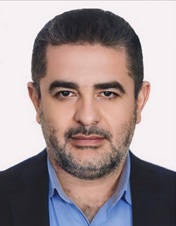
Murad Saeed Sedeeq
Research InterestsEnergy
Solar energy
Life cycle assesment
Thermodynamics
HVAC systems
| Gender | MALE |
|---|---|
| Place of Work | Technical Engineering College/ Kirkuk |
| Position | Lecturer staff |
| Qualification | Master |
| Speciality | Thermal engineering/ Energy |
| murad.sedeeq@ntu.edu.iq | |
| Phone | 07701302280 |
| Address | Baghdad road, Center of Kirkuk, Kirkuk, Iraq |
Skills
تحليل البيئي لدورة حياة المنتجات (50%)
رسم الاجزاء الميكانيكية باستخدام برنامج SolidWorks (50%)
تحليل الجريان و انتقال الحرارة باستخدام Ansys Fluent (40%)
Academic Qualification
بكالوريوس
Oct 1, 1998 - Jul 1, 2002لقد اتممت دراسة البكالوريوس في هيئة التعليم التقني / الكلية التقنية كركوك / قسم هندسة تقنيات التبريد و التكييف و بتسلسل الاول على القسم
ماجستير
Sep 1, 2010 - Jan 10, 2013لقد اتممت دراسة الماجستير حسب قانون الاجازة الدراسية في التركيا في جامعة غازي عنتاب قسم الهندسة الميكانيكية فرع الطاقة
دكتوراه
Sep 10, 2023 - Presentلازلت مستمرا في دراسة الدركتوراه في الجامعة التقنية الشمالية / الكلية التقنية الهندسية كركوك / قسم هندسة تقنيات ميكانيك القوى
Working Experience
مقرر قسم [مقرر الدراسات الاولية]
Sep 1, 2015 - Sep 1, 2020Publications
Comparative exergoenvironmental analysis and assessment of various residential heating systems
Dec 4, 2013Journal Energy and Buildings
publisher elsevier
DOI https://doi.org/10.1016/j.enbuild.2013.03.024
Volume 62
This paper uses exergoenvironmental analysis to tackle the energetic, exergetic, and environmental performance of three heating systems commonly used in the residential building sector in Turkey: a conventional coal boiler, a condensing natural gas boiler, and a ground source heat pump. This analysis presents a combination of exergy analysis and life cycle assessment (LCA). The obtained results show that the ground source heat pump is an efficient heating system for the given application from a thermodynamic perspective in terms of the coefficient of performance and exergy efficiency with values of 2.5 and 10%, respectively. On the other hand, the LCA results demonstrate that the system-related environmental impact associated with ground source heat pump is the highest among the compared systems. Based on exergoenvironmental analysis the environmental impact per kWh exergy demand for each system is found to be 4.0, 1.69, and 1.93 mPt/kWh, respectively. This demonstrates that using an efficient system from thermodynamic perspective does not offer a significant environmental advantage and Turkey must renounce the use of coal in heating applications as soon as possible in order to get rid of environmental burdens as the first step and should promote the use of natural gas at building level in order to generate heating energy.
Thermodynamic analysis and life cycle assessment of the heating strategies in historical buildings: a case study
Feb 28, 2014Journal International Journal of Exergy
publisher Inder science
DOI https://doi.org/10.1504/IJEX.2014.059513
Issue 1
Volume 14
This paper presents the thermodynamic analysis and life cycle assessment (LCA) of the heating strategies in historical buildings. We evaluated two main systems used in historical buildings to provide heat: a central heating system, which is based on a method of heating the whole air volume within the building, and a localised heating system, which is based on a method of supplying the desired amount of heat to the individual occupants. After evaluating both systems in a historic mosque, we found that using a modern localised heating system like the carbon film heating, a comfortable temperature can be maintained while saving 22.4 MWh of electricity annually, compared with a conventional central heating system. Moreover, the carbon film heating system can reduce stress on the environment by 60% when compared with the conventional heat pump system.
Environmental Impact and Life Cycle Assessment of Economically Optimized Thermal Insulation Materials for Different Climatic Region in Iraq
Jan 1, 2018Journal International Journal of Engineering & Technology
publisher -
DOI http://dx.doi.org/10.14419/ijet.v7i4.37.24094
Issue 7
Volume 4
Environmental pollution is one of the biggest problems facing the world, even it is the most dangerous. Therefore, it becomes necessary to combine all efforts to reduce or eliminate it. Iraq is at the forefront of countries that suffer from major environmental problems. The present study aims to perform a comparative environmental assessment for three commonly available thermal insulation materials in Iraq namely expanded polystyrene (EPS), extruded polystyrene (XPS), and rock wool (RW) to select least environmental impact material. A cradle to gate life cycle assessment is performed to assess the environmental impact of each insulation material taking into account manufacturing, transportation, and installation and disposal stages. A life cycle assessment program SimaPro is used to model thermal insulation materials during its life cycle. A life cycle impact analysis method CML 2001 has been selected to assess the environmental aspects associated with two global damage categories as ozone layer depletion and global warming and two regional damage categories as acidification and eutrophication. Economically optimized amount of each insulation material is selected to represent the functional unit of life cycle assessment. The results illustrate that the EPS has the lower contribution in all environmental impact categories for all climatic regions. So, the EPS can be select as a proper thermal insulation material for the building sector from an economic and environmental perspective. The results of LCA are used to determine the amount of CO2 can be reduced per meter square of the exterior wall by using the economical amount of EPS during the lifetime of insulation material. The environmental impact results show that using EPS will contribute in CO2 emission reduction at about 81.5 % in all climatic regions in Iraq.
Calculation and modelling of cooling degree-hours for some Iraqi cities
Jan 1, 2019Journal Journal of Engineering and Applied Sciences
publisher Inder science
DOI https://doi.org/10.1504/IJEX.2014.059513
Issue 14
Volume 14
The current study dealt with the calculation and modeling of cooling degree-hours for some Iraqi cities, represented by Mosul city as a model for the Northern cities, Baghdad as a model for the central cities and Basra as a model for the Southern cities. This research was based on previous actual dry-bulb temperature data recorded over the previous 10 years. These data were used to calculate the actual values of the cooling degree-hours for different base temperatures ranging from 14-28°C to cover all cooling application requirement data. In turn, these data were used to obtain the appropriate mathematical model which can be used to calculate cooling degree-hours values from any base temperature with a small error rate ranging from 0-4% over the Summer months for all locations. And after the success of the developed model in three studied cities which represented three different climatic pattern regions in Iraq, developed model can be used as a general model to predicate the cooling degree-hours for any location in Iraq at any base temperature after knowing the mean value and the standard deviation of the dry-bulb temperature for the concerned location






